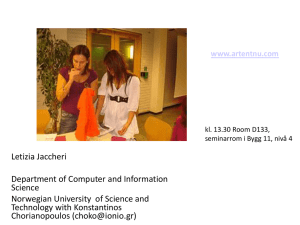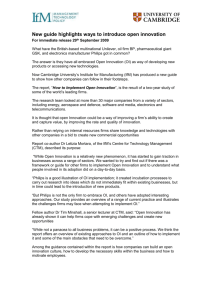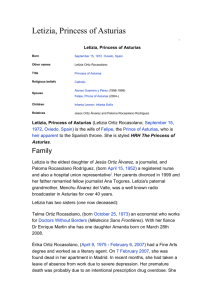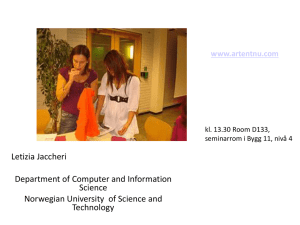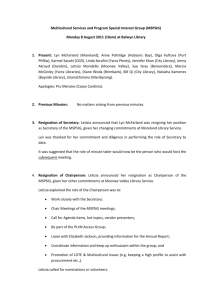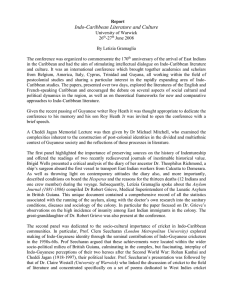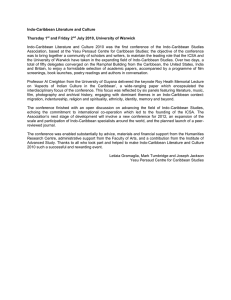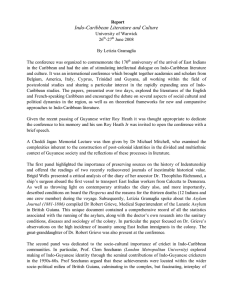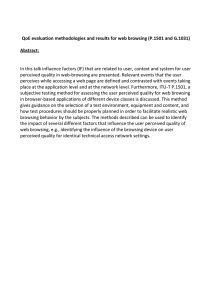Document 13784223
advertisement
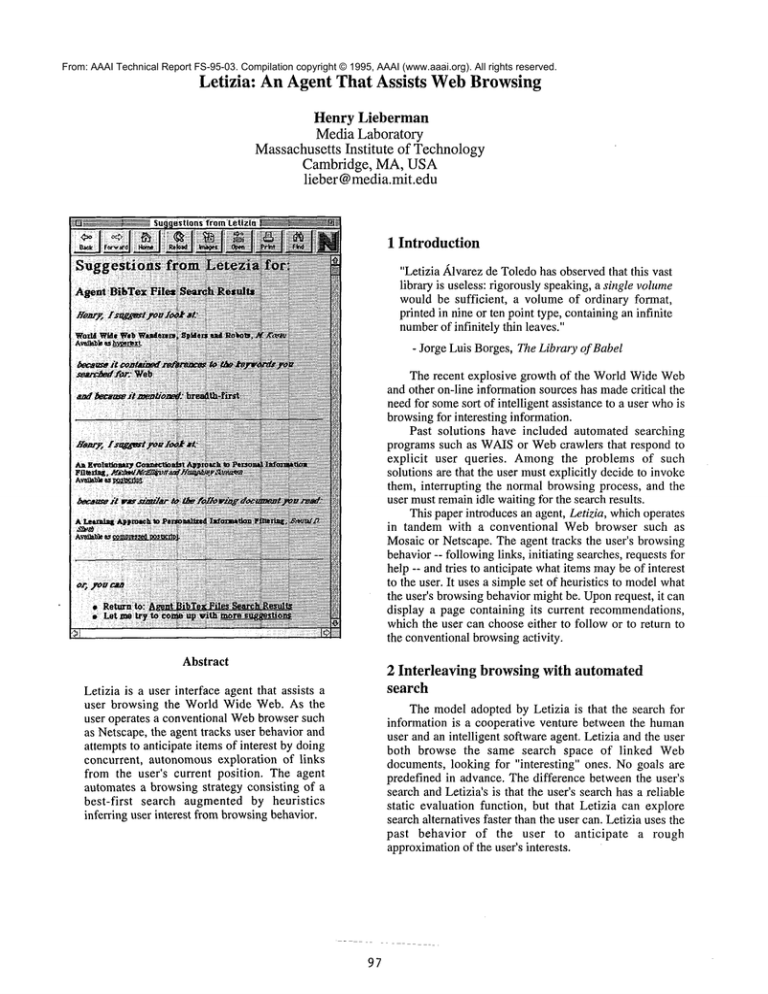
From: AAAI Technical Report FS-95-03. Compilation copyright © 1995, AAAI (www.aaai.org). All rights reserved. Letizia: An Agent That Assists WebBrowsing Henry Lieberman Media Laboratory Massachusetts Institute of Technology Cambridge,/VIA, USA lieber@media.mit.edu 1 Introduction "Letizia Alvarez de Toledohas observedthat this vast library is useless: rigorously speaking, a single volume would be sufficient, a volume of ordinary format, printed in nine or ten point type, containingan infinite numberof infinitely thin leaves." - Jorge Luis Borges, The Library of Babel The recent explosive growth of the World Wide Web and other on-line information sources has madecritical the needfor somesort of intelligent assistance to a user whois browsingfor interesting information. Past solutions have included automated searching programs such as WAISor Webcrawlers that respond to explicit user queries. Amongthe problems of such solutions are that the user must explicitly decide to invoke them, interrupting the normal browsing process, and the user mustremainidle waiting for the search results. This paper introduces an agent, Let/z/a, whichoperates in tandem with a conventional Webbrowser such as Mosaic or Netscape. The agent tracks the user’s browsing behavior-- followinglinks, initiating searches, requests for help -- and tries to anticipate what items maybe of interest to the user. It uses a simple set of heuristics to modelwhat the user’s browsingbehavior might be. Uponrequest, it can display a page containing its current recommendations, whichthe user can choose either to follow or to return to the conventional browsingactivity. Abstract 2 Interleaving browsingwith automated search Letizia is a user interface agent that assists a user browsing the World Wide Web. As the user operates a conventional Webbrowser such as Netscape, the agent tracks user behavior and attempts to anticipate items of interest by doing concurrent, autonomous exploration of links from the user’s current position. The agent automates a browsing strategy consisting of a best-first search augmented by heuristics inferring user interest from browsingbehavior. The model adopted by Letizia is that the search for information is a cooperative venture between the human user and an intelligent software agent. Letizia and the user both browse the same search space of linked Web documents, looking for "interesting" ones. No goals are predefined in advance. The difference between the user’s search and Letizia’s is that the user’s search has a reliable static evaluation function, but that Letizia can explore search alternatives faster than the user can. Letizia uses the past behavior of the user to anticipate a rough approximationof the user’s interests. 97 Critical to Letizia’s design is its control structure, in which the user can manually browse documents and conduct searches, without interruption from Letizia. Letizia’s role during user interaction is merely to observe and makeinferences from observation of the user’s actions that will be relevant to future requests. In parallel with the user’s browsing,Letizia conductsa resource-limited search to anticipate the possible future needsof the user. At any time, the user mayrequest a set of recommendations from Letizia based on the current state of the user’s browsing and Letizia’s search. Such recommendations are dynamically recomputed when anythingchangesor at the user’s request. Letizia is in the tradition of behavior-basedinterface agents [Maes94], [Lashkari, Metral, and Maes94]. Rather than rely on a preprogrammedknowledge representation structure to make decisions, the knowledge about the domainis incrementally acquired as a result of inferences fromthe user’s concrete actions. Letizia adopts a strategy that is midwaybetween the conventional perspectives of information retrieval and information filtering [Sheth and Maes 93]. Information retrieval suggests the image of a user actively querying a base of [mostly irrelevant] knowledge in the hopes of extracting a small amountof relevant material. Information filtering paints the user as the passive target of a stream of [mostly relevant] material, where the task is to removeor de-emphasizeless relevant material. Letizia can interleave both retrieval and filtering behaviorinitiated either by the user or by the agent. 3 Modeling the user’s Because Letizia can assume to be operating in a situation where the user has invited its assistance, its simulation of the user’s intent need not be extremely accurate for it to be useful. Its guesses only needbe better than no guess at all, and so even weakheuristics can be employed. 4 Inferences behavior browsing process The user’s browsingprocess is typically to examinethe current HTMLdocument in the Web browser, decide which, if any, links to follow, or to return to a document previously encountered in the history, or to return to a documentexplicitly recorded in a hot list, or to add the current documentto the hot list. The goal of the Letizia agent is to automatically perform some of the exploration that the user wouldhave done while the user is browsing these or other documents, and to evaluate the results from what it can determineto be the user’s perspective. Uponrequest, Letizia provides recommendationsfor further action on the user’s part, usually in the form of following links to other documents. Letizia’s leverage comesfrom overlapping search and evaluation with the "idle time" during which the user is reading a document. Since the user is almost always a better judge of the relevance of a document than the system, it is usually not worth makingthe user wait for the result of an automatedretrieval if that wouldinterrupt the browsing process. The best use of Letizia’s recommendationsis whenthe user is unsure of what to do next. Letizia never takes control of the user interface, but just provides suggestions. 98 from the user’s browsing Observation of the user’s browsing behavior can tell the system muchabout the user’s interests. Each of these heuristics is weakby itself, but each can contribute to a judgmentabout the document’sinterest. Oneof the strongest behaviorsis for the user to save a reference to a document, explicitly indicating interest. Followinga link can indicate one of several things. First, the decision to follow a link can indicate interest in the topic of the link. However,because the user does not know what is referenced by the link at the time the decision to follow it has been made, that indication of interest is tentative, at best. If the user returns immediatelywithout having either saved the target document, or followed further links, an indication of disinterest can be assumed. Letizia saves the user considerable time that would be wastedexploring those "dead-end"links. Following a link is, however, a good indicator of interest in the documentcontaining the link. Pages that contain lots of links that the user finds worth followingare interesting. Repeatedly returning to a document also connotes interest, as wouldspendinga lot of time browsing it [relative to its length[, if we trackeddwelltime. Since there is a tendency to browselinks in a top-tobottom, left-to-fight manner, a link that has been "passed over" can be assumed to be less interesting. A link is passed over if it remains unchosenwhile the user chooses other links that appear later in the document.Later choice of that link can reverse the indication. Letizia does not have natural language understanding capability, so its content modelof a documentis simply as a list of keywords.Partial natural languagecapabilities that can extract some grammatical and semantic information quickly, even though they do not perform full natural language understanding [Lehnert 93] could greatly improve its accuracy. Letizia uses an extensible object-oriented architecture to facilitate the incorporation of new heuristics to determine interest in a document,dependent on the user’s actions, history, and the current interactive context as well as the content of the document. Userbrowsesmanypageshaving to do with "Agents". System infers interest in the topic "Agent". Animportant aspect of Letizia’s judgmentof "interest" in a documentis that it is not trying to determine some measureof howinteresting the documentis in the abstract, but instead, a preferenceordering of interest amonga set of links. If almost every link is found to have high interest, then an agent that recommendsthem all isn’t muchhelp, and if very few links are interesting, then the agent’s recommendation isn’t of much consequence. At each moment,the primary problemthe user is faced with in the browser interface is "which link should I choose next?", And so it is Letizia’s job to recommendwhich of the several possibilities available is most likely to satisfy the user. Letizia sets as its goal to recommenda certain percentage [settable by the user] of the links currently available. Later, the user independentlybrowsesa personalWeb page,with a publicationslist. Letizia recommends articles havingto do with "Agents". 99 5 An example In the example, the user starts out by browsing home pages for various general topics such as Artificial Intelligence. Our user is particularly interested in topics involving Agents, so he or she zeros in on pages that treat that topic, such as the general Agent Info page, above. Manypages will have the word Agent in the name, the user maysearch for the wordAgentin a search page, etc. and so the systemcan infer an interest in the topic of Agcntsfrom the browsingbehavior. At a later time, the user is browsing personal home pages, perhaps reached through an entirely different route. A personal homepage for an author maycontain a list of that author’s publications. As the user is browsingthrough some of the publications, Letizia can concurrently be scanning the list of publications to find which ones may havc relevance to a topic for whichinterest was previously inferred, in this case the topic Agents. Thosepapers in the publication list dealing with agents are suggested by Letizia. Letizia can also explain why it has chosen that document.In manyinstances, this represents not the only reason for having chosen it, but it selects one of the stronger reasons to establish plausibility. In this case, it noticed a keywordfrom a previous exploration, and in the other case, a comparisonwas madeto a documentthat also appearedin the list returned by the bibliographysearch. 6 Persistence of interest Oneof the most compellingreasons to adopt a Letizialike agent is the phenomenonof persistence of interest. Whenthe user indicates interest by following a link or performing a search on a keyword, their interest in that topic rarely ends with the returning of results for that particular search. Thoughthe user typically continues to be interested in the topic, he or she often cannot take the time to restate interest at every opportunity, whenanother link or search opportunity arises with the sameor related subject. Thus the agent serves the role of rememberingand looking out for interests that wereexpressedwith past actions. Persistence of interest is also valuable in capturing users’ preferred personal strategies for finding information. ManyWebnodes have both subject-oriented and personoriented indices. The Webpage for a university or companydepartment typically contains links to the major topics of the department’s activity, and also links to the homepages of the department’s personnel. A particular piece of work maybe linked to by both the subject and the author. Someusers may habitually prefer to trace through personal links rather than subject links, because they may already have friends in the organization or in the field, or i00 just because they maybe moresocially oriented in general. An agent such as Letizia picks up such preferences, through references to links labeled as "People", or through noticing particular namesthat mayappear again and again in different, thoughrelated, contexts. Indications of interest probably ought to have a factor of decaying over time so that the agent does not get clogged with searching for interests that mayindeed have fallen from the user’s attention. Someactions may have been highly dependent upon the local context, and should be forgotten unless they are reinforced by more recent action. Another heuristic for forgetting is to discount suggestions that were formulated very far in "distance" from the present position, measuredin numberof web links from the original point of discovery. Further, persistence of interest is important in uncovering serendipitous connections, which is a major goal of information browsing. While searching for one topic, one might accidentally uncover information of tremendousinterest on another, seeminglyunrelated, topic. This happenssurprisingly often, partly because seemingly unrelated topics are often related through non-obvious connections. An important role for the agent to play is in constantly being available to notice such connections and bring themto the user’s attention. numberis reached, Letizia remains quiescent until the next user-initiated interaction. Letizia will not initiate further searches when it reaches a page that contains a search form, even though it could benefit enormouslyby doing so, in part because there is as yet no agreed-upon Web convention for timebounding the search effort. Letizia will, however, recommendthat a user go to a page containing a search form. In practice, the pacing of user interaction and Letizia’s internal processing time tends to keep resource consumption manageable. Like all autonomous Web searching "robots", there exists the potential for overloading the net with robot-generated communication activity. Weintend to adhere to conventions for "robot exclusion" and other "robot ethics" principles as they are agreed upon by the network community. 8 Related work Workon intelligent agents for information browsingis still in its infancy. The closest workto this is [Armstrong, et. al. 95], especially in the interface aspects of annotating documents that are being browsed independently by the user. Letizia differs in that it does not require the user to state a goal at the outset, instead trying to infer "goals" implicitly from the user’s browsing behavior. Also quite relevant is [Balabonovic and Shoham95], which requires the user to explicitly evaluate pages. Again,we try to infer evaluations from user actions. Both explicit statements of goals and explicit evaluations of the results of browsing actions do have the effect of speeding up the learning algorithm and makingit more predictable, at the cost of additional user interaction. [Etzioni and Weld 94], [Knoblockand Arens 93], and [Perkowitz and Etzioni 95] are examples of a knowledgeintensive approach, where the agent is pre-programmed with an extensive modelof what resources are available on the network and howto access them. The knowledge-based approach is complementaryto the relatively pure behaviorbased approach here, and they could be used together. Automated "Webcrawlers" [Koster 94] have neither the knowledge-basedapproach nor the interactive learning approach,. They use more conventional search and indexing techniques. They tend to assume a more conventional question-and-answer interface mode, where the user delegates a task to the agent, and then waits for the result. They don’t have any provision for making use of concurrent browsing activity or learning from the user’s browsing behavior. Laura Robin [Robin 90] explored using an interactive, resource-limited, interest-dependent best-first search in a browser for a linked multimedia environment. Someof the ideas about control structure were also explored in a different context in [Lieberman89]. 7 Search strategies The interface structure of many Web browsers encourages depth first search, since every time one descends a level the choices at the next lower level are immediately displayed. One must return to the containing documentto explore brother links at the same level, a twostep process in the interface. Whenthe user is exploring in a relatively undirected fashion, the tendencyis to continue to explore downward links in a depth-first fashion. After a while, the user finds him or herself very deep in a stack of previously chosen documents, and [especially in the absence of muchvisual representation of the context] this leads to a "lost in hyperspace"feeling. The depth-first orientation is unfortunate, as much informationof interest to users is typically embedded rather shallowly in the Webhierarchy. Letizia compensates for this by employinga breadth-first search. It achieves utility in part by remindingusers of neighboring links that might escape notice. It makesuser exploration moreefficient by automatically eliding manyof the "dead-end" links that wasteusers’ time. The depth of Letizia’s search is also limited in practice by the effects of user interaction. Webpages tend to be of relatively similar size in terms of amount of text and numberof links per page, and users tend to movefrom one Webnode to another at relatively constant intervals. Each user movementimmediately refocuses the search, which preventsit fromgetting too far afield. The search is still potentially combinatorially explosive, so we put a resource limitation on search activity. This limit is expressed as a maximum numberof accesses to non-local Webnodes per minute. After that i01 9 Implementation Letizia is implementedin Macintosh Common Lisp. It uses Netscape as a Webbrowser and user interface. The agent runs as a separate process, and communication between Lisp and Netscape takes place using AppleEvents and AppleScript interprocess communication. Currently, we are severely limited by the extent to whichNetscape is programmablevia AppleEvents. HTML is parsed using the Zebu parser-generator [Laubsch94]. Acknowledgments This work has been supported in part by research grants to the MIT Media Laboratory from Alenia, ARPA/JNIDS, Apple Computer, the National Science Foundation, and other MediaLab sponsors. [Maes 94] Pattie Maes, Agents that Reduce Work and Information Overload, Communicationsof the A CM, July 1994. [Perkowitz and Etzioni 95] Mike Perkowitz and Oren Etzioni, Category Translation: Learning to Understand Information on the Internet, International Joint Conference on Artificial Intelligence, Montrral, August 1995. [Robin 90] Robin, Laura, Personalizing Hypermedia: The Role of Adaptive Multimedia Scripts, MSThesis, MassachusettsInstitute of Technology,1990. [Sheth and Maes 93] Beerud Sheth and Pattie Maes, Evolving Agents for Personalized Information Filtering, IEEEConferenceon Artificial Intelligence for Applications, 1993. References [Armstrong, Freytag, Joachims and Mitchell 95] Robert Armstrong, Dayne Freitag, Thorsten Joachims and TomMitchell, WebWatcher: A Learning Apprentice for the World Wide Web, in AAAI Spring Symposium on Information Gathering, Stanford, CA, March1995. [Balabonovic and Shoham 95] Marko Balabanovic and YoavShoham,Learning Information Retrieval Agents: Experiments with Automated WebBrowsing, in AAA/ Spring Symposium on Information Gathering, Stanford, CA, March1995. [Etzioni and Weld 94] Oren Etzioni and Daniel Weld, A Softbot-Based Interface to the Internet, Communicationsof the ACM,July 1994. [Knoblockand Arens 93] Craig Knoblockand Yigal Arens, An Architecture for Information Retrieval Agents, AAAI Symposium on Software Agents, Stanford, CA, March 1993. [Koster 94] M. Koster, World Wide Web Wanderers, Spiders and Robots, http:// web.nexor.co.uk/ mak/doc/robots/robots.html [Lashkari, Metral, and Maes 94] Yezdi Lashkari, Max Metral, Pattie Maes, Collaborative Interface Agents, Conferenceof the AmericanAssociation for Artificial Intelligence, Seattle, August1994. [Laubsch 94] Zebu: A Tool for Specifying Reversible LALR(1)Parsers, Hewlett-Packard Laboratories, 1994. [Lehnert and Sundheim 91] Wendy Lehnert and B. Sundheim, A Performance Evaluation of TextAnalysis Technologies," AI Magazine,p. 81-94, 1991 [Lieberman 89] Henry Lieberman, Parallelism in Interpreters for Knowledge Representation Systems, in Concepts and Characteristics of Knowledge-Based Systems, M. Tokoro, Y. Anzai, A. Yonezawa, eds., North-Holland, 1989. 3.02
